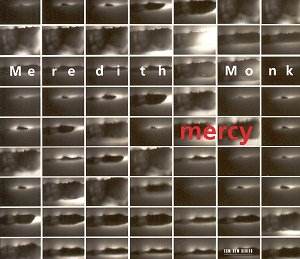Choreographer, dancer, multimedia artist, Meredith Monk is
also – and, I would say, first and foremost – a composer who has written
a sizeable vocal output (often for her own voice) finding many new ways
of using the voice, and continuously exploring the human voice in all
its possibilities, as is evident when listening to her large-scale piece
mercy recorded here for the first time.
Mercy was originally conceived as a
multimedia project with installation artist Ann Hamilton. The present
release is, as already mentioned, its premiere recording made with the
original cast although it also includes several pieces written before
Monk started working with Hamilton. These include the writing for Bohdan
Hilash’s clarinets which was not featured in the stage work as well
as some music for mallet instruments and the Epilogue. The whole piece
is some sort of synthesis of Monk’s musical thinking and music making
since this is also the first time that Monk has written for mallet instruments
played here by John Hollebeck.
As a whole, mercy is a meditation on
the quality of mercy throughout history, and a humanistic demand for
mercy in troubled times. Needless to say that all this is particularly
badly needed given the present universal social and political environment.
Literary sources are manifold ranging from contemporary world literature
to historical documents and the daily news. Musically speaking, Monk
relies on the whole gamut of vocal production from whisper to screaming.
Voices are also aptly and often subtly supported by the instruments,
which undoubtedly adds a further dimension to Monk’s music, which –
to a certain extent – might be best described as sophisticated Minimalism
though there is much more to it than this description might suggest.
On the whole, it is a much more complex work, technically and emotionally.
There are some really impressive moments in this substantial score from
the composer’s full maturity.
However, one’s reaction will depend on how one can
attune (or not) to the global conception of the work. I for one am rather
undecided about it, but this has nothing to do with the quality of the
music and, most of all, the sincerity and honesty of Monk’s humanistic
concerns. I think that this performance can not be bettered for all
concerned have a long working association with Monk who also takes part
in it as one of the vocalists. Nevertheless, as is often the case either
with similar multimedia works or with some operas, the absence of the
important visual element considerably lessens the global impact of the
piece. One’s reaction to any piece of art is (nearly) always a matter
of subjectivity, and probably the more so with a highly personal and
even idiosyncratic work as this one.
This is a clear ECM product notable for the interest
of the music, the quality of the playing and the recording, but also
for the conspicuously sketchy insert notes (which, in the present instance,
is a euphemism for there are no insert notes as such but rather a series
of close-ups of wide-open mouths, and most of the above comments have
been drawn from the press information provided).
So, in short, an unquestionably sincere and honest
piece of music making superbly played and recorded; but ,in the last
instance, it is up to you to decide whether Monk’s musical world appeals
to you or not.
Hubert Culot

